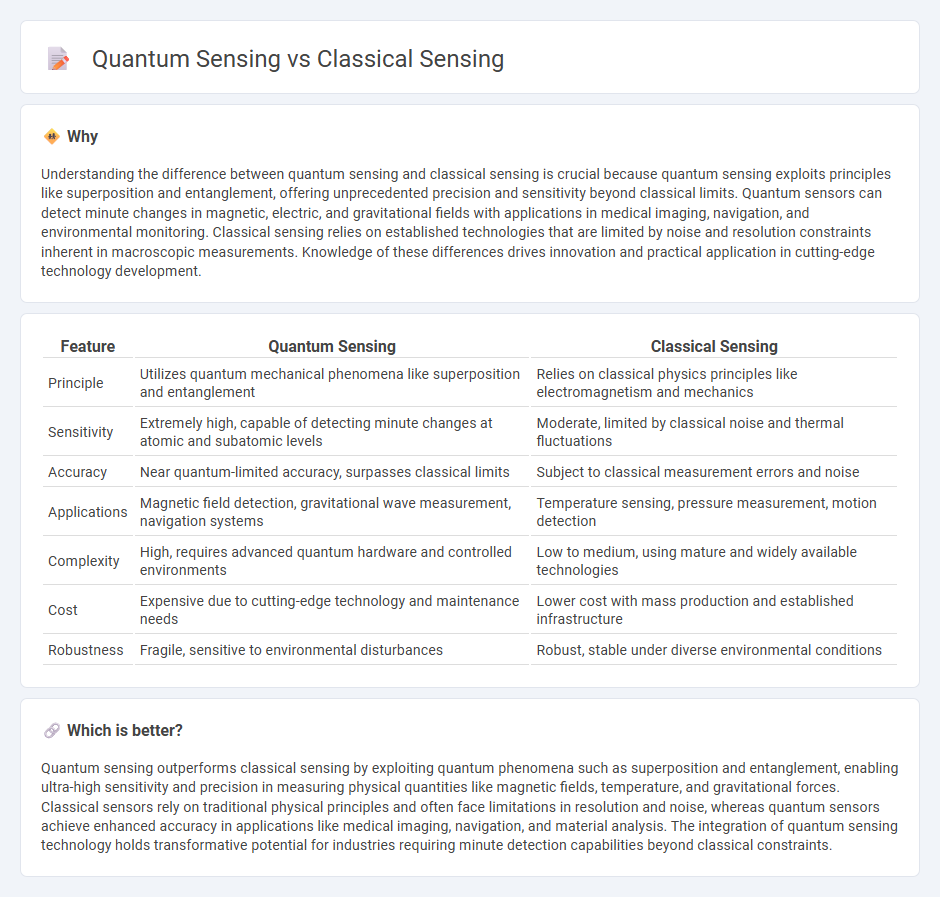
Quantum sensing leverages quantum mechanics principles such as superposition and entanglement to achieve unprecedented precision in measuring physical quantities like magnetic fields, gravitational forces, and temperature variations. Classical sensing relies on conventional physical phenomena and often faces limitations in sensitivity and accuracy compared to quantum sensors. Explore how quantum sensing is revolutionizing measurement technologies beyond classical capabilities.
Why it is important
Understanding the difference between quantum sensing and classical sensing is crucial because quantum sensing exploits principles like superposition and entanglement, offering unprecedented precision and sensitivity beyond classical limits. Quantum sensors can detect minute changes in magnetic, electric, and gravitational fields with applications in medical imaging, navigation, and environmental monitoring. Classical sensing relies on established technologies that are limited by noise and resolution constraints inherent in macroscopic measurements. Knowledge of these differences drives innovation and practical application in cutting-edge technology development.
Comparison Table
| Feature | Quantum Sensing | Classical Sensing |
|---|---|---|
| Principle | Utilizes quantum mechanical phenomena like superposition and entanglement | Relies on classical physics principles like electromagnetism and mechanics |
| Sensitivity | Extremely high, capable of detecting minute changes at atomic and subatomic levels | Moderate, limited by classical noise and thermal fluctuations |
| Accuracy | Near quantum-limited accuracy, surpasses classical limits | Subject to classical measurement errors and noise |
| Applications | Magnetic field detection, gravitational wave measurement, navigation systems | Temperature sensing, pressure measurement, motion detection |
| Complexity | High, requires advanced quantum hardware and controlled environments | Low to medium, using mature and widely available technologies |
| Cost | Expensive due to cutting-edge technology and maintenance needs | Lower cost with mass production and established infrastructure |
| Robustness | Fragile, sensitive to environmental disturbances | Robust, stable under diverse environmental conditions |
Which is better?
Quantum sensing outperforms classical sensing by exploiting quantum phenomena such as superposition and entanglement, enabling ultra-high sensitivity and precision in measuring physical quantities like magnetic fields, temperature, and gravitational forces. Classical sensors rely on traditional physical principles and often face limitations in resolution and noise, whereas quantum sensors achieve enhanced accuracy in applications like medical imaging, navigation, and material analysis. The integration of quantum sensing technology holds transformative potential for industries requiring minute detection capabilities beyond classical constraints.
Connection
Quantum sensing leverages quantum phenomena such as superposition and entanglement to achieve ultra-sensitive measurements beyond classical limits, enhancing precision in fields like magnetometry and gravimetry. Classical sensing technologies typically rely on macroscopic physical properties and established measurement techniques, providing robust and accessible data acquisition. Integration of quantum sensing with classical systems enables hybrid devices that combine quantum accuracy with classical scalability, driving advancements in medical imaging, navigation, and environmental monitoring.
Key Terms
Measurement Precision
Classical sensing techniques rely on macroscopic physical principles, offering measurement precision limited by intrinsic noise and environmental factors. Quantum sensing leverages quantum superposition and entanglement to achieve unprecedented sensitivity, surpassing classical limits such as the standard quantum limit or shot noise. Explore how quantum sensors revolutionize precision measurement across fields like metrology, imaging, and navigation.
Quantum Entanglement
Classical sensing relies on conventional measurement techniques with limited sensitivity, while quantum sensing exploits quantum entanglement to enhance precision beyond classical limits. Quantum entanglement enables correlated quantum states that improve signal-to-noise ratios, leading to breakthroughs in magnetic field detection, gravitational wave observation, and nanoscale imaging. Explore the transformative potential of quantum entanglement in sensing technologies to understand how it revolutionizes measurement accuracy.
Noise Sensitivity
Classical sensing techniques are limited by noise sensitivity, often resulting in reduced precision due to environmental disturbances and intrinsic system fluctuations. Quantum sensing leverages phenomena like entanglement and superposition to surpass classical noise limits, achieving enhanced measurement sensitivity and accuracy. Explore the advantages of quantum sensing to understand its transformative potential in precision measurement applications.
Source and External Links
An Overview of Quantum Sensing and Metrology - Classical sensing technologies, such as accelerometers and clocks, are widely used for motion and time measurement but are fundamentally limited by device imperfections and environmental noise.
The Future of Inertial Navigation is Classical-Quantum Sensor Fusion - Classical sensors excel at high-frequency measurements and wide measurement ranges but are less accurate and require regular calibration due to accumulated errors and drift.
Quantum vs. Classical Complementary PNT - Classical sensing technologies remain cost-effective and mature for many everyday applications, despite their limitations in precision and susceptibility to environmental factors compared to quantum alternatives.
 dowidth.com
dowidth.com